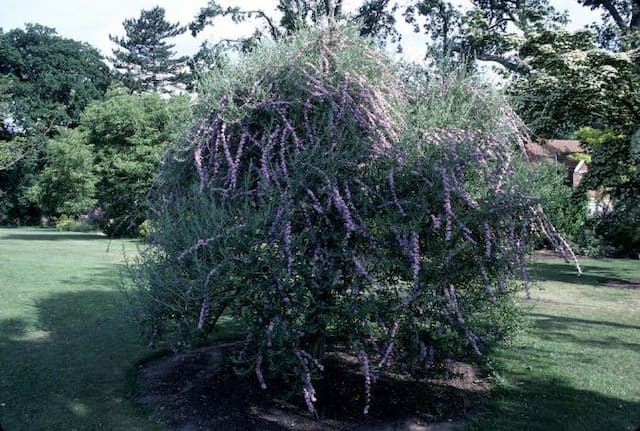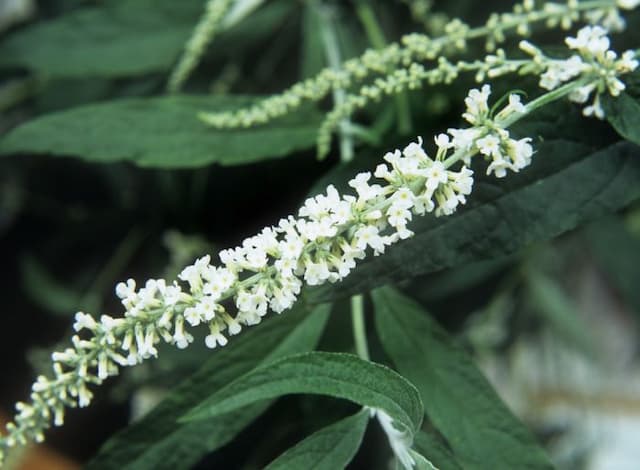Orange Ball Tree Buddleja globosa

ABOUT
The plant commonly known as Orange Ball Tree is a sight to behold with its distinct spherical clusters of bright orange flowers, which offer a profusion of bloom mainly in the later spring to early summer period. These vibrant, sweet-scented flowers are tightly packed together forming pom-pom-like globes that hang gracefully from the branches, attracting various pollinators including bees and butterflies. The leaves of the Orange Ball Tree are another attractive aspect; they are lance-shaped and have a textured surface, presenting a medium to dark green hue. Each leaf is oppositely arranged on the stems, creating a sense of order and pattern on the woody branches of the shrub. The overall form of the Orange Ball Tree is somewhat rounded, giving it a bushy, robust appearance. The bark on the older stems provides a sense of maturity with its rough texture and grayish-brown color, contrasting the soft, green foliage and the cheerful orange of the flowering clusters.
About this plant
 Names
NamesFamily
Scrophulariaceae
Synonyms
Orange Ball Tree, Orange Buddleia, Globe Buddleja
Common names
Buddleia globosa.
 Toxicity
ToxicityTo humans
The Orange Ball Tree is not commonly known to be toxic to humans. However, ingesting any part of the plant is not recommended as it may cause gastrointestinal discomfort or other non-specific symptoms in some individuals.
To pets
There is limited information on the toxicity of the Orange Ball Tree to pets, but it is not typically listed as a poisonous plant for dogs and cats. As with humans, ingestion of non-food plants can sometimes cause gastrointestinal upset in pets, so it is advisable to prevent pets from eating this plant.
 Characteristics
CharacteristicsLife cycle
Perennials
Foliage type
Deciduous
Color of leaves
Green
Flower color
Orange
Height
10 7 [3.2 m]
Spread
10 7 [3.2 m]
Plant type
Shrub
Hardiness zones
7
Native area
Chile
Benefits
 General Benefits
General Benefits- Attracts Pollinators: Buddleja globosa, commonly known as Orange Ball Tree, is highly attractive to bees, butterflies, and other pollinating insects, enhancing pollination in the garden.
- Landscape Aesthetics: With vibrant orange ball-shaped flowers, the Orange Ball Tree adds a splash of color and exotic beauty to landscapes and gardens.
- Habitat for Wildlife: The dense foliage and flowers provide shelter and breeding spots for birds and insects, contributing to biodiversity.
- Erosion Control: The robust rooting system of Buddleja globosa can help stabilize soil and prevent erosion in sloped areas of the garden.
- Privacy Screen: Due to its potential to grow into a large shrub, it can be used as an informal hedge or screen, providing privacy and reducing wind impact.
- Low Maintenance: The Orange Ball Tree is known for its durability and can thrive with minimal care, making it suitable for low-maintenance gardening.
- Scented Flowers: The blooms of Buddleja globosa emit a pleasant fragrance that can enhance the sensory experience of any garden space.
- Drought Tolerance: Once established, the plant exhibits good resistance to drought, reducing the need for frequent watering.
 Medical Properties
Medical Properties- Antimicrobial: Buddleja globosa may hold properties that help in fighting certain types of bacteria and fungi.
- Anti-inflammatory: There have been indications that extracts from the plant might reduce inflammation.
- Antipyretic: Traditionally, the plant may have been used to reduce fever, although scientific evidence to support this use is limited.
- Analgesic: Some sources suggest the plant has been used to relieve pain, although robust scientific data backing this claim are lacking.
 Air-purifying Qualities
Air-purifying QualitiesThis plant is not specifically known for air purifying qualities.
 Other Uses
Other Uses- Insect Attractant: Buddleja globosa is planted to attract beneficial insects into the garden, serving as a natural pest control by enticing predators of harmful insects.
- Butterfly Garden Essential: This plant is an exceptional addition to butterfly gardens, providing nectar to a variety of butterfly species and encouraging their presence in the area.
- Hedge Plant: Because of its dense foliage and fast growth, Buddleja globosa can be used to create privacy screens or hedges in landscaping.
- Windbreak: In areas prone to strong winds, the robust nature of this plant makes it suitable for use as a windbreak to protect more delicate plants.
- Fragrance Source: The sweet scent of Buddleja globosa flowers makes it a popular choice for planting near windows or sitting areas to enjoy its fragrance.
- Erosion Control: The plant's root system can help to stabilize slopes and banks, making it useful for erosion control in landscaping.
- Decorative Dried Flowers: The spherical orange blooms can be dried and used in floral arrangements or as part of craft projects.
- Wildlife Shelter: The dense branches of Buddleja globosa provide shelter and nesting sites for birds and other small wildlife.
- Ecological Research: Sometimes used in ecological studies to understand plant-insect interactions and the role of nectar plants in local ecosystems.
- Culinary Garnish: Although not widely known for its culinary uses, the flowers can sometimes be used as an edible garnish, adding a splash of color to various dishes.
Interesting Facts
 Feng Shui
Feng ShuiThe Orange Ball Tree is not used in Feng Shui practice.
 Zodiac Sign Compitability
Zodiac Sign CompitabilityThe Orange Ball Tree is not used in astrology practice.
 Plant Symbolism
Plant Symbolism- Transformation: The orange ball tree, also known as Buddleja globosa, can symbolize change as it attracts butterflies which are often associated with transformation, growth, and renewal.
- Attraction: As a natural attractant for butterflies and bees, the orange ball tree is emblematic of allure and magnetic charm.
- Hope: Because it blooms vigorously and can adapt to various conditions, the orange ball tree may represent hope and encouragement through adversity.
- Prosperity: As a plant that can grow abundantly, it may symbolize growth and the potential for prosperity.
 Water
WaterThe Orange Ball Tree should be watered regularly, allowing the soil to dry out slightly between waterings. During the growing season, usually spring and summer, it may need to be watered once every week with approximately 1 to 2 gallons of water, depending on the size of the plant and the climate conditions. In the fall and winter, reduce watering to every two weeks or when the soil feels dry to the touch. Ensure the plant has well-draining soil to prevent waterlogging, which could lead to root rot.
 Light
LightThe Orange Ball Tree thrives best in full sunlight but can also tolerate partial shade. The ideal spot for this plant would be where it can receive at least six hours of direct sunlight daily. A south-facing garden or a location that receives unfiltered sunlight for the majority of the day would be most beneficial for its growth and flowering.
 Temperature
TemperatureThe Orange Ball Tree prefers a temperate climate with temperatures ranging between 40°F and 100°F. It can tolerate occasional dips below freezing but should not be exposed to extended periods of extreme cold. The ideal temperature range for this plant is between 60°F and 85°F, where it can flourish and produce its characteristic orange blooms.
 Pruning
PruningPrune the Orange Ball Tree to promote healthy growth, maintain its shape, and encourage more blooms. The best time to prune is in late winter or early spring before new growth begins. Remove any dead, diseased, or overcrowded branches, and cut back up to one-third of the older stems to stimulate fresh growth. Pruning should be done annually or as needed to maintain the desired form.
 Cleaning
CleaningAs needed
 Soil
SoilOrange Ball Tree thrives in well-draining soil that is rich in organic matter. A mix of loam, peat, and coarse sand in equal parts can provide the necessary drainage and nutrients. Aim for a soil pH between 6.0 and 7.0 for optimal growth.
 Repotting
RepottingOrange Ball Tree, being a large shrub, is typically not repotted as it is generally planted outdoors. In its initial stages, if grown in a container, repotting can be done every 2-3 years to provide adequate space for root growth.
 Humidity & Misting
Humidity & MistingOrange Ball Tree is tolerant of a wide range of humidity levels but prefers moderate humidity. It can thrive well in typical outdoor environments without the need for special humidity adjustments.
 Suitable locations
Suitable locationsIndoor
Place in bright, indirect light and allow space for growth.
Outdoor
Plant in full sun to partial shade with shelter from strong winds.
Hardiness zone
7-10 USDA
 Life cycle
Life cycleBuddleja globosa, commonly known as the Orange Ball Tree, begins its life cycle with seed germination, which requires a well-drained substrate and light for optimal growth. After germination, seedlings develop into young plants with characteristic lance-shaped leaves. The plant then enters a vegetative stage characterized by the growth of woody stems and the development of foliage. When mature, Buddleja globosa reaches the flowering stage, typically in late spring or early summer, producing distinctive globe-shaped orange blossoms that attract a variety of pollinators. After pollination, the flowers develop into small capsules containing seeds, which disperse to begin a new life cycle. In temperate regions, the plant may enter a period of dormancy in the winter before resuming growth in the spring.
 Propogation
PropogationPropogation time
Spring-early summer
Propogation: Orange Ball Tree, or Buddleja globosa, is commonly propagated through semi-hardwood stem cuttings. The most suitable time for this propagation method is late summer to early autumn. To propagate, a cutting of about 6 inches (approximately 15 cm) in length is taken from a healthy, non-flowering branch. The lower leaves of the cutting are removed, and the cut end is dipped in rooting hormone to encourage root growth. The treated cutting is then inserted into a well-draining potting medium and kept under conditions of high humidity and indirect sunlight. After some weeks, the cutting will develop roots and can be gradually acclimatized to outdoor conditions before being transplanted into the garden.




![Butterfly bush [Florence]](/_next/image?url=https%3A%2F%2Fplants-admin.emdemapps.com%2Fimages%2Fplants%2F%2Fimages%2F604b5f52d7bb1.png&w=640&q=75)




